- NASA Home
- | Centers
- | Dryden Home
- | History
- | Past Projects
- | Hyper-X
Search Dryden
Dryden History
Hyper-X
Hyper-X, NASA's multi-year hypersonic flight research program was designed to overcome one of the greatest aeronautical research challenges - air-breathing hypersonic flight. The X-43A was a small experimental research aircraft designed to flight-demonstrate the technology of airframe-integrated supersonic ramjet or "scramjet" propulsion at hypersonic speeds above Mach 5, or five times the speed of sound. Its scramjet engine is an air-breathing engine in which the airflow through the engine remains supersonic.

Far outpacing any supersonic aircraft, the three X-43A vehicles were designed to fly at speeds of Mach 7 and 10. Ultimately, the revolutionary technologies exposed by the Hyper-X Program promise to increase payload capacities and reduce costs for future air and space vehicles.
MicroCraft, Inc. of Tullahoma, Tenn., (now ATK GASL) was the industry partner chosen by NASA to construct the X-43 vehicles. The contract award announcement occurred on March 24, 1997, with construction of the vehicles beginning soon thereafter. Orbital Sciences Corporation's Launch Vehicles Division in Chandler, Ariz. constructed the Hyper-X launch vehicles.
The Hyper-X Phase I program was an agency-wide effort, conducted jointly by Dryden and Langley, to demonstrate technology that could ultimately be applied in vehicle types from hypersonic aircraft to reusable space launchers. Each of the vehicles is 12 feet long with a span of about five feet.
Background
One of the primary goals of NASA's Aeronautics Enterprise, as delineated in the NASA Strategic Plan, specified the development and demonstration of technologies for air-breathing hypersonic flight. Following the cancellation of the National Aerospace Plane (NASP) program in November 1994, the United States lacked a cohesive hypersonic technology development program. As one of the "better, faster, cheaper" program developed by NASA in the late 1990s, Hyper-X used National Aerospace Plane technology, and was to quickly moving it forward to the next step, which was demonstration of hypersonic air breathing propulsion in flight.
Project Objectives
The goal of the Hyper-X program were to flight validate key propulsion and related technologies for air-breathing hypersonic aircraft. The first two X-43 vehicles were scheduled to fly at Mach 7. This is far faster than any air-breathing aircraft have ever flown. The world's fastest air-breathing aircraft, the SR-71, cruises slightly above Mach 3. The highest speed attained by NASA's rocket-powered X-15 was Mach 6.7, back in 1967. The third X-43A was to reach a speed of Mach 10.
Flight at Hypersonic Speeds
The first X-43A was launched from the NASA B-52B on June 2, 2001. Shortly after ignition of the Pegasus, a failure occurred, and the booster had to be destroyed by the range safety officer. The subsequent investigation traced the mishap to a failure of the flight control system. This was due to incorrect modeling of the forces generated by a launch at 20,000 feet, rather than the normal 40,000 foot altitude. This lower drop altitude was necessary to achieve the Mach 7 burnout speed for separation of the X-43.
The investigation, making the necessary design changes, and proving that they would work required nearly three years of effort. The major change was raising the launch altitude to 40,000 feet, to make the Hyper-X profile similar to that of a standard Pegasus booster. To maintain the Mach 7 separation speed, some three thousand pounds of solid rocket propellant was removed from the Pegasus. (Solid rockets like the Pegasus cannot be shut down in flight, but rather must burn all their fuel.) Other modifications to both Pegasus and X-43A systems were also made to correct potential problems the investigation discovered.
The second X-43A was successfully flown on March 27, 2004. After separation from the Pegasus, the X-43A’s scramjet ignited. The engine was able to develop more thrust than the drag on the vehicle, and it accelerated. This was one of the research goals of the flight. The X-43A set a record speed of Mach 6.83 or about 4,900 mph. This was the first time a scramjet engine had ever operated in flight. After the engine burn was completed, the X-43A performed maneuvers for hypersonic aerodynamic data. It finally fell into the Pacific Ocean in the planned impact zone.
The third X-43A flight was planned to reach Mach 10. This flight involved considerably more unknowns than the Mach 7 mission. While a complete Mach 7 scramjet engine burn could be simulated in a wind tunnel, the same was not true at Mach 10. At this higher speed, wind tunnels could only create the proper conditions for 1/1000 of a second during a single run. With a burn time of some ten seconds, the third X-43A flight would return orders of magnitude more data at this speed than some four decades of ground testing.
The flight was made on Nov. 16, 2004, and reached a speed of Mach 9.6, or almost 7,000 mph. The X-43A was able to cruise at this speed, meaning engine thrust matched drag. This was the cruise speed for the vehicle design, and demonstrating this ability was a mission goal. The scramjet operated as predicted, showing the ground simulations were accurately. As with the previous flight, the X-43A performed maneuvers during the glide down for aerodynamic data, before hitting the Pacific.
The X-43A/Hyper-X program accomplished several important goals. It provided the first free flight data on scramjet engines. It also showed the predictive tools used to design the engine were accurate. They could then be used to design more advanced scramjets with longer burn times. The X-43A transformed a promising but unproved concept into a reality. The Hyper-X also trained a new generation of engineers, scientists, and researchers in hypersonic flight. Finally, it provided a glimpse into the future. The X-43A’s engine had operated for about ten seconds. 101 years before, the Wright brothers flew a heavier than air vehicle for 12 seconds.
For more X-43A information, visit: www.nasa.gov/missions/research/x43-main.html
Additional Links
| Fact Sheet | Photo Collection | Movie Collection |